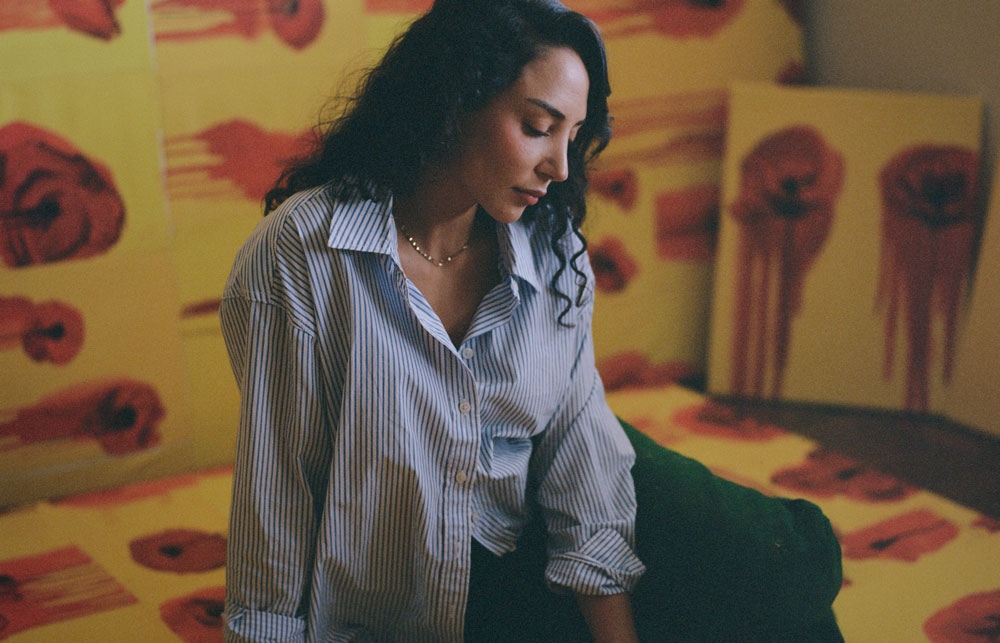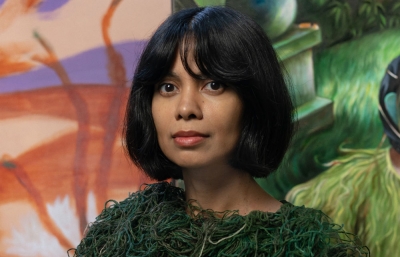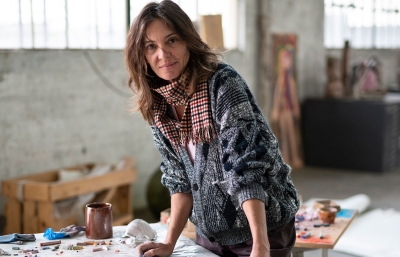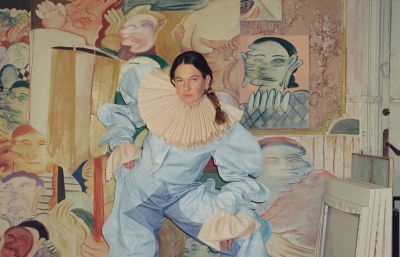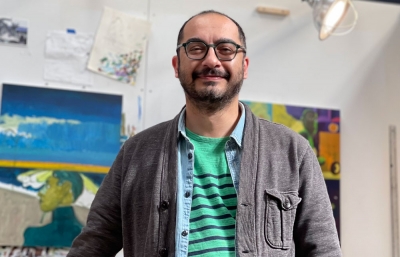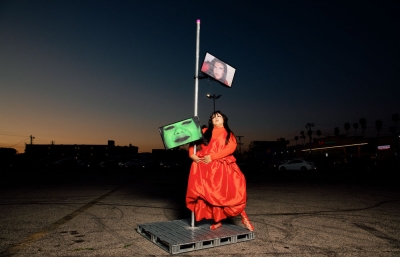Saj Issa
The Action Painter
Interview by Evan Pricco // Portrait by Kholood Eid
I have been thinking a lot about the origins of the concept of a utopia. War and political turmoil can force us to wish for something more ideal, a situation where the living world can live together in what we could call social harmony. The idea of utopia also leads to wondering about land and how to share it. French painter André Derain once wrote, “There is only one kind of painting: landscape. It is the most difficult. It has also, I believe, the most simple kind of composition. Because no one can stop us from imagining the world in the way that pleases us most.” It’s the latter part of this quote that struck a chord, as I consider such social reform—this imaginary society where exemplary qualities may be relative to the dreamer but universal in their aims. It was the great architect Buckminster Fuller who said, “The world is now too dangerous for anything less than Utopia.” In a sense, both Fuller and Derain seem to say, “The world as we want it to be is imagined, and probably never actually lived.”
Prior to my conversation with Saj Issa this past summer in Los Angeles, I had just returned from a trip to Aberdeen, Scotland, where the topic among colleagues was centered around the idea that art created or placed in public was inherently political. It seemed so well timed that I would be speaking to Issa right then, just as the St. Louis-based, Palestinian-American artist graced the cover of Artforum with a now iconic photo of her painting on a hillside in the West Bank, overlooking an Israeli settlement while on her family’s land. For Issa, the intent of returning to her family home near Ramallah after graduating from UCLA’s MFA program was supposed to be a time to explore the romantic essence of painting: think Matisse’s Landscape at Collioure. Then, on October 7, Issa was forced to change course and re-examine the intention of her art. Or maybe, instinctively, her art just changed.

Over the past year, Issa has become a lot of things she didn’t expect to be: an activist artist, a spokesperson for Palestinian independence, and a resource regarding the conflict as many Americans come to understand the war and Palestine’s demand for sovereignty. But speaking to Saj this summer, she reiterated how this was never her goal, and upon returning to the West Bank in late spring 2024, she found purpose in the action she intended in her year abroad prior to October 7th: to paint the landscape. Over the course of our one-hour conversation, we spoke about painting the land and the desire to record this place, a landscape in turmoil and physically altered with an utopian dream of calmer days ahead. And in this act of painting the land, she enriches the story of how to speak about the present.
Evan Pricco: A lot has happened since we last talked. We’ll get into the political environment, but let’s start with how it feels to be out of the academic world and making work outside of that context? Do you miss it, or are you happy that graduation is in the past and you can confront the world the way you want without grades and that sort of critique?
Saj Issa: It does feel nice to work alone and not hear people's opinions before I even have a chance to process them myself. I haven't heard any artists say that it's taken a turn for the worse working alone right now. So it kind of feels nice that I have my own routine and am not meeting a deadline, whether it be something school-related or even gallery-related, too. I'm able to just experiment more, and it feels very liberating.
It's so fascinating to think about being critiqued before you’ve given yourself a chance to consider what you’ve made. I guess this is life in a nutshell.
I think that there's something that artists are in denial about in academia, that is, making something to impress others. When you are alone, you don't have to show any of those things you don't want to. But in school, you are required to share what's in your studio, what you are working on right at that moment, and also have to show your drafts. It was UCLA, so you have a critique, and Rodney McMillian is about to come to your studio in five minutes! You have to ask yourself, “What do I feel comfortable showing him?” You feel like you need to tell people the parameters for which to see your work, and then when you get feedback, there are things you don’t want to hear quite yet! Alone, you can set those rules as opposed to explaining the rules.

Is it more stressful to discuss art with an instructor or a gallerist?
The teacher. You can bullshit way more with the business hat on, in my opinion. You can begin the conversation with credit rather than intelligence when it comes to business. When a lot of my mentors talk about meeting with galleries, they always use dating as a reference. They're, like, you have to date your gallerists. Not literally, but it's the same approach when it comes to dating. Some dates in my studio were more fruitful with my instructors, and some were better with the gallerists. There’s a lot more wordiness, or inaccessibility, when you talk to an instructor. Galleries just talk about the right now, the right here.
Oh, I get it. An instructor wants to know what, where, why, and when, and sometimes a gallerist will be more blunt: “This is what works; this is why; this is where.”
Correct. And it's not necessarily just commercial conversations that I was having. It could be something a lot more casual about what kind of experiences you have that influenced this work. Whereas meeting with my instructors was more, "What artists, social issues, or literature is your work in conversation with?" Academia really strives to uphold a level of integrity with art, apart from the market.
I keep wondering if you were prepared for this moment. At your MFA show, you made deliberate, beautifully photoreal paintings and ceramics that were about the heritage and legacy of the West Bank. Within those, there was a tradition of Palestinian iconography with a disruption of Western logos and culture. And now, you have been such a pivotal voice since October 7, 2023, which runs parallel to a pivot in your work. You are painting the emotion and motion of the current moment, not so much looking back but facing time and culture directly. So were you prepared for this change, and is this the right question?
No. I think that's a great question, and absolutely, I was not prepared. I’m used to making work and then sitting with it for a minute to digest. Now it kind of feels like my work is being talked about immediately. I'm very flattered by it, honestly. But at the same time, it's kind of daunting to know I didn't have a full year after school yet to even gather myself to fully do the work I was wanting or expecting to do.
My expectation, this timeline that I set prior to October 2023, was that I was going to make a body of work for a year, experiment, and see what came out of that before I’d even show it to anyone. And because everything was just so immediately unfolding, I began to work from a more impromptu, immediate approach, and as a result, my art changed a lot. Whereas in the past, I was able to make premeditated artworks, making drafts. Now it's just like, go, go, go… literally, start working as an action painter.
So that is something you consciously understand that you have done.
Yes, and I was really scared because I thought, “Will I be taken seriously?” Because you set these rules whenever you're working and create a habit, and that was kind of the rule that I was following when I went to the West Bank before October 7th, to take my time and develop. And now it's like I have really nothing to lose.

“And now it's like I have really nothing to lose.”
I was speaking to our mutual friend, Addam Yekutieli, about the changing landscape of creating art during war. I was thinking of Picasso's painting, Guernica, which was done in reflection of the April 1937 bombing of a town in the Basque Country by the Nazis and Italian fascists. The painting itself was unveiled to an audience in July 1937 in the Spanish Pavilion at the Paris International Exposition, where the Nazis also had a huge pavilion. That was pretty damn immediate—a masterwork as an action painting, so to speak. But now, artists are almost asked to go faster, to articulate major moments, and to reflect in real-time. It’s a beautiful responsibility, but a challenge to reflect history as it's happening.
I think it's kind of in parallel with how fast technology is growing—just the speed at which it's being innovative. That's the line where I see art being consumed and made today. It is becoming a lot faster. Contemporary art and technology are on the same parallel path.
What was your goal when you left UCLA?
I moved my practice to Palestine and wanted to have a more conservative, European approach to art-making. My studio is still there, on the first floor of my parent’s house on the outskirts of Ramallah. I had a much more romantic approach to art-making in mind, kind of what I imagined Picasso or Matisse would have done. It's like a luxury type of lifestyle, just like picking fruit from your garden, making these paintings, and really directly responding to the landscape rather than time. It was immediate in that sense, but it was more representational paintings that I was making, as well as sketches and drawings.

That was your intention—to get away from LA and St. Louis, then just paint for a year and experiment?
Well, I didn't have access to a ceramic studio at the time. There were just all these road restrictions that were a barricade to me in physically getting to the ceramic studio that I intended to work out of in Hebron. And so I said to myself, “You know what? Let's take it back to the basics of just painting and drawing.” I began to really investigate types of rural architecture, investigating and reflecting on how we live with old things, but particularly, architecture and these gorgeous kinds of landscapes.
But there is a thread from what you were doing in the past, this blend of architecture with logos and how that affects the landscape. You were touching on that at UCLA.
Yes, my work was, I don't want to say controlled, but just almost photographic. Photoreal. When I got the studio in the West Bank, I wanted to make a sketch of my commute around the West Bank. I'd take photos along the way. And what I have to say is that a lot of the experiences I was having were... look, the best way to say it is that there's no time for leisure. Leisure is not an option when you are walking the streets of the West Bank. If you are Palestinian, you have to have a specific action and keep going. So I'd take these photos and use my camera as a tool of documentation, so I could then go back and have leisure time in my studio and approach creating landscape drawings and paintings. And then that evolved post-October 7th.
Since you were near Ramallah before October 7, 2023, are you describing the months leading up to this?
Correct. There was this increasing animosity and hostility growing in the air. I just felt like I couldn't be here and that a war was about to break out. I didn't want to be there for that.
I think this is part of understanding why your voice became so important in the art and greater social world, because you were there. You also had the opportunity to communicate in a way Americans could understand because you were born in America and knew the vernacular for explaining the conflict in ways that audiences could understand more clearly. Does that seem to reflect what you were doing?
Yeah, I never really thought about it that way. I think that when it comes to a voice taken seriously, it's not only the language but also the physical appearance. Just being racially and religiously ambiguous. I mean, a lot of people are surprised whenever I tell them I’m Palestinian. It's really unfortunate the way that they're able to humanize me and take what I say seriously just because of an indeterminate appearance or because I have an approach they weren't expecting.
In reference to the work you were making during what was supposed to be a long stay of leisure, how did it feel when you brought it back to the States? Did the meaning of the work change from its original intent?
Yes, completely. Alongside those architectural ruin paintings, I was working on floral botanical paintings that were very representational as well. The reasoning was to paint something that was just very apolitical, and that was literally my approach—to be Matisse and make very romanticized paintings.

The idea of going to paint apolitical things in a very, very volatile place in the world feels quite profoundly political and, actually, quite subversive.
Well, indeed. So I come home and continue painting these ruins and flora. I just kept working simultaneously on those two things. All I could think of was that I wanted to paint the Palestinian landscape. So that was my only goal.
I was working here in my St. Louis studio for several months and just feeling hopeless. I went to a protest with my friend, and part of me was thinking, “This has happened to Palestinians throughout our lives; I don't think that a protest is the approach that I want to have. I’m not going to make a slogan protest poster.” She's like, “Come on, what are you working on?” At the time, I was making these poppy paintings, and because I didn’t want to make a poster, I thought, “You know what? I'm just going to carry this painting with me.” Growing up, whenever you're walking the streets and you're holding a poster, especially during a demonstration, you're walking past people who are dining at restaurants, who are looking out the windows, and they'll make a stumped face at you. But from the reactions that I got when I held the painting, I was able to hold their gaze a lot longer than a poster.
That’s incredible. Without any text on it, right?
Without any text. The colors weren't symbolic of a flag or anything, either, so it was just extremely inscrutable. When I was alongside other people who were holding flags and posters that had words on them, I would hold my painting. The reaction I got was just that people didn't know if they should curse at me or look away, which people usually do if you hold a sign with a phrase on it in their face. With the painting, they were just kind of confused, as if they didn’t know how they should feel.
This is the beauty of good interventionist art, in how it can surprise and confound expectations of what art can be and where it should be. You were basically doing a walking intervention.
And again, it was an approach where I'm hopeless, walking around with an ego that I have nothing to lose. It was a social experiment for myself and this inner troll in me that I posses..
Having interviewed you numerous times over the last 18 months, I feel that you have a really subtle but good sense of humor.
I just like to do things to make myself laugh. And the world's pretty absurd right now, so there's an opportunity to sort of do the biggest eye roll possible about everything.
What has surprised you about the way the world has reacted in the last, let’s say, year by the time this comes out? Not just about your art, but toward Palestine and greater conversations about war and occupation?
The amount of advocacy is absolutely astonishing, in places where you would least expect it. Let me give you an example: You're shopping for a new car and think to yourself that you are getting this particular car, but then you find yourself driving on the street and seeing that car everywhere—in exactly the color you wanted. It's just like this car and color are everywhere, and you say, “Wow, how many people have this thing?!” That's what being Palestinian feels like now. It's so personal, and it's who I am, so I can't tell if everyone's actually talking about this or if it's coming to the forefront of my consciousness because I'm paying attention to it a lot more than other people. But what I have noticed, and it has surprised me, is that I definitely think people are talking about it a lot more.

Are you able to talk about the relationship the art world has had with this war, or is it something that you aren’t ready to speak about?
Don’t force me to say it.
Let’s talk about when you go back to the West Bank after October 7, in the spring of 2024. Did you go back with a sense of purpose that you wouldn't normally have? I’m thinking about a series of works that were made there, especially the photo of you painting the landscape of Palestine that was on the cover of Artforum recently.
I had a very specific purpose for going there. I was under immense stress because my grandfather was going through it with his health. The trip was extremely abrupt and really kind of crazy to book a plane ticket within 12 hours of traveling internationally into a war zone. And I understood that I was so privileged to be able to pick up where I left off in my studio there so that I could begin my mornings the same way I did every day with a stroll around the village. And I thought, because there are so many travel restraints at the moment, who is to say I can't paint on this hillside right now? The leisure restraint I'd mentioned earlier is always a challenge, but my parents own that particular plot of land where I made a painting. That land has a zone restriction placed on it by Israel to prevent anyone from building anything on the land. The reason being is because there's a road specifically accessible to Israelis to drive on in the West Bank that's close to my parents' land. I thought, Let me just paint en plein air and enjoy my morning tea, and treat this space as something very domestic—the land my parents own, overlooking the village and this apartheid road. It was so nice to have that type of leisure there, in that moment and morning. Everything is so fast-paced in the West Bank that you have to always be on a specific mission. It was nice to sit there, embrace the moment, and be mesmerized by the abundant beauty of the landscape, truly. Even though I'm directly looking out onto a settlement across from my family's village and I'm aware of how much havoc the violence that comes from the settlement wreaks, mesmerized is really the only word I can use.
Everything was just so gorgeous; I almost would've forgotten that I was in a war zone if I hadn't seen spirals of smoke in the sky. That was the thing that kind of brought me to the forefront of just being in this space and then remembering what this is.
I think, circling back to your question regarding the conversation about this and the art world, the reason why I wanted to have such a conservative approach as opposed to being very specific about making protest work was because I felt like this was also an act of resistance on its own, to just make a plein air painting. If I'm able to make this plein air painting, that's very fundamental and goes back to the foundations of pictorial painting. Why can't we talk about it? And if you add that extra context of where it is and at what time in history, then whatever animosity or whatever hostility that you have in response is clearly a reflection of your own nature.

So, do you consider yourself a political artist?
That's a good question. No. I have met political artists in the past, and what I was able to learn from them is the way they work from history and art history. I think that's a practice of its own. But really, I think that if I were of a different ethnicity, making work about my personal upbringing and my environment, which is not so much at the forefront of contemporary news and politics right now, I wouldn't be seen as political. Like, if I were an Australian artist who was responding to the landscape of Australia, would that be seen as political?
Saj Issa will take part in the Great Rivers Biennial alongside Basil Kincaid and Ronald Young at the Contemporary Art Museum St. Louis through February 9, 2025. This interview was originally published in the FALL 2024 Print Quarterly edition and conducted at "I'd Love To See You: A Juxtapoz Magazine Story at 30" on view at Rusha & Co this summer.

